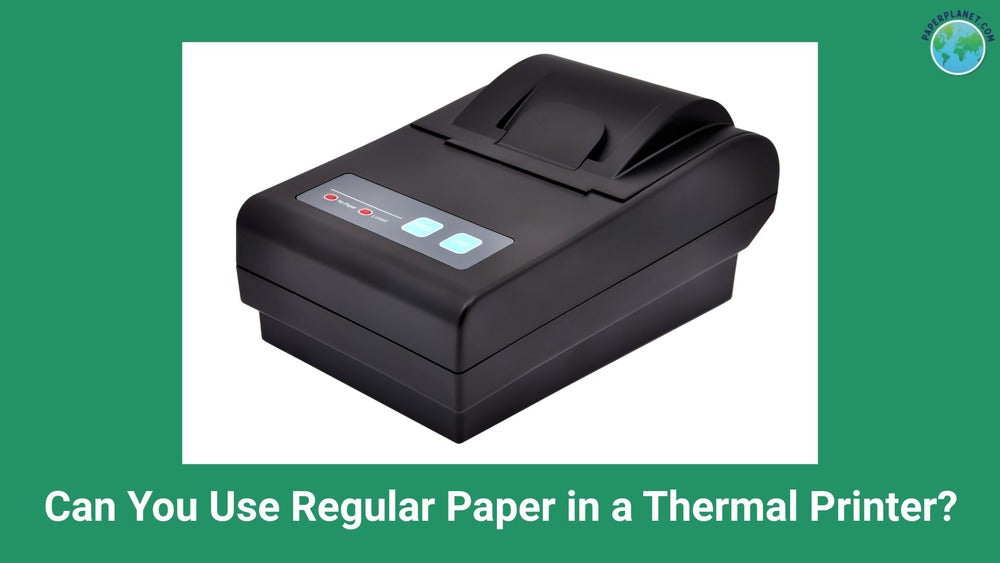Can You Use Regular Paper in a Thermal Printer?

Thermal printers have reshaped how businesses handle everyday printing tasks. They’re fast, efficient, and cost-effective. That’s why they’re widely used in e-commerce for shipping labels. You’ll also find them in hospitals, stores, and warehouses.
But one question often arises: Can you use regular paper in a thermal printer?
The short answer is no. It’s a common misunderstanding, but thermal printers require thermal paper. Regular paper simply won’t work. Keep reading to discover why—and what could happen if you try.
What Makes Thermal Paper Different From Regular Paper?
Thermal paper is coated with heat-sensitive chemicals that react to a printer’s thermal head, producing text or images without ink or toner. This coating usually includes a base layer, a reactive layer, and often a protective topcoat to help delay fading.
Regular paper lacks this coating and relies on ink or toner for printing. It comes in various finishes such as matte, glossy, or textured, and is commonly used with inkjet or laser printers.
Thermal paper typically feels smoother and can seem thinner, though its thickness varies. It is more sensitive to environmental factors—especially heat, light, and moisture—which can cause printed images to fade over time. For this reason, thermal paper is generally best for short to medium-term use.
In contrast, when produced with high-quality ink or toner, prints on regular paper tend to last longer and are more suitable for archival storage. Thermal paper remains ideal for fast, high-volume applications like receipts, shipping labels, and barcode printing, where long-term durability isn't the primary concern.
Can You Use Regular Paper in a Thermal Printer?

No, you cannot.
Thermal printers don’t use ink or toner. They use heat. If you feed regular paper into a thermal printer, nothing happens. You’ll get a blank sheet.
That’s because regular paper doesn’t react to heat. It wasn’t made for that kind of printing. Thermal printers depend on chemical coatings on the paper to produce an image. Without that coating, the printer has nothing to work with.
What Happens If You Try to Use Regular Paper in a Thermal Printer?
Trying to print on regular paper with a thermal printer leads to three main issues:
- Blank output: The printer applies heat, but nothing shows up. You’ll think the machine is broken when the paper is just wrong.
- Printer damage: Thermal heads aren’t made to run against untreated surfaces, which can overheat them and shorten their lifespan.
- Wasted resources: Time, paper, and possibly repair costs if the printer gets worn out from improper use.
In short, using regular paper doesn’t just fail—it creates unnecessary problems.
What About Using Thermal Paper in a Regular Printer?
You might wonder if you can use thermal paper in an inkjet or laser printer. While it's physically possible, it's not recommended. Thermal paper has a chemical coating that can leave residue inside the printer over time.
These printers aren’t designed to handle coated paper. The heat from laser printers or the ink from inkjets may react with the coating, potentially causing buildup on rollers or print heads. Sometimes, this can affect print quality or reduce the printer's lifespan.
Although thermal paper is generally safe, using standard paper in non-thermal printers is best to avoid long-term issues.
Why Thermal Paper Is Non-Negotiable for Thermal Printers
Thermal paper is designed for thermal technology. That’s why it works so well.
Here’s what you get with thermal paper:
- No ink or toner required
- Fast, clean prints
- Long-lasting images, when stored properly
Thermal paper is ideal for environments that need durable, smudge-free output, especially in high-traffic or high-volume settings.
How Thermal Printing Works (In Simple Terms)

The thermal printer heats tiny points on its printhead. These heated points contact the thermal paper, which darkens only where heat is applied.
There are two types:
- Direct thermal printing: Uses only heat and thermal paper. No ribbon or ink involved.
- Thermal transfer printing: Uses a heated ribbon to transfer ink to different materials.
If you're using direct thermal, thermal paper is a must. Regular paper won’t cut it.
How to Tell the Difference Between Regular and Thermal Paper
Not sure which type you’re holding? Try this:
- Scratch test: Rub the paper with a coin or your fingernail. If it turns dark, it’s thermal paper.
- Label check: Most rolls will say “thermal” and sometimes note if they’re BPA-free.
If it doesn’t react to heat or scratching, it’s just standard paper.
Final Thoughts
Regular paper doesn’t work in thermal printers. It won’t produce an image and can wear down the printhead over time. Thermal paper is specially made to react to heat, giving fast, clean, and reliable results.
Use the right paper to protect your printer and ensure every label or receipt looks sharp. Paper Planet offers high-quality, BPA-free thermal paper that fits most POS systems and meets the demands of busy environments.
Always use the correct supplies for optimal performance and to prevent unnecessary downtime. Thermal printing relies on specific paper designed for it to function properly.

